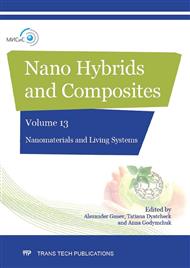p.232
p.239
p.248
p.255
p.263
p.268
p.279
p.288
p.294
The Effects of Nanosilver, Encapsulated in a Polymeric Matrix, on Albino Rats Brain Tissue
Abstract:
We showed the results of immunohistochemical investigation of outbred albino rat’s neural tissue exposed to 9-day exposure of nanobiocomposite, which consist silver nanoparticles encapsulated in natural biopolymer matrix - arabinogalactan. Investigation of white rats was composed of 2 stages: half of the rats in each group were sacrificed immediately after exposure (early period) and other rats – through 6 months after end of exposure (distant period). We showed that test substance causes functional changes in nervous tissue. After subacute administration of nanobiocomposite - argentumarabinogalaktan (nAG) we have observed changes of content of apoptotic and anti-apoptotic proteins caspase-3 and bcl-2 in nervous tissue of white rats. number of normal neurons producing the protein caspase-3 was increased sharply and number of immunonegative normal neurons was significantly reduced. Along with this there was a high level of bcl – 2, one function of which is to prevent apoptosis trigger. We revealed in samples a significant increase in number of neurons with bcl-2, but protective effect of this protein not fully realized, which leads to significant increase of amount ofdamaged hyperchromatic cells. Assessment of results of immunohistochemical study of white rat’s nervous tissue, according to the expression of the protein caspase-3 and bcl – 2, may lead conclusion about ability of nanosilver encapsulated in a polymer matrix to penetrate blood-brain barrier and induced start apoptotic cascade in cortical neurons.
Info:
Periodical:
Pages:
263-267
Citation:
Online since:
January 2017
Authors:
Keywords:
Price:
Сopyright:
© 2017 Trans Tech Publications Ltd. All Rights Reserved
Share:
Citation:


